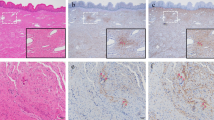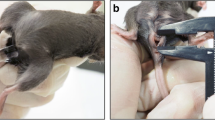Abstract
Introduction and hypothesis
This pilot study compares protein expression patterns in the pubocervical fascia of women with pelvic organ prolapse (POP) and stress urinary incontinence (SUI) and asymptomatic women with normal pelvic support.
Methods
Samples of pubocervical fascia were collected from four women with POP and SUI and from three asymptomatic (control) women. These were analyzed using two-dimensional electrophoresis and matrix-assisted laser desorption/ionization time-of-flight mass spectrometry.
Results
The expression levels of transgelin, smooth muscle gamma-actin, myosin light polypeptide 6, and alpha-1 antitrypsin precursor were more than twofold higher in patients than in controls. An additional five proteins were overexpressed (more than twofold) in patients, while three proteins were detected only in the patients.
Conclusion
This pilot study is the first study to estimate changes in protein expression in the pubocervical fascia of human patients with POP. These changes could be related to the pathophysiology of POP.



Similar content being viewed by others
Abbreviations
- POP:
-
Pelvic organ prolapse
- UI:
-
Urinary incontinence
- MS:
-
Mass spectrometry
- 2-DE:
-
Two-dimensional electrophoresis
- MALDI-TOF-MS:
-
Matrix-assisted laser desorption/ionization time-of-flight MS
References
Weber AM, Buchsbaum GM, Chen B, Clark AL, Damaser MS et al (2004) Basic science and translational research in female pelvic floor disorders: proceedings of an NIH-sponsored meeting. Neurourol Urodyn 23:288–301
DeLancey JO (1992) Anatomic aspects of vaginal eversion after hysterectomy. Am J Obstet Gynecol 166:1717–1724, discussion 1724–1718
Jelovsek JE, Maher C, Barber MD (2007) Pelvic organ prolapse. Lancet 369:1027–1038
Buchsbaum GM, Duecy EE, Kerr LA, Huang LS, Perevich M et al (2006) Pelvic organ prolapse in nulliparous women and their parous sisters. Obstet Gynecol 108:1388–1393
Soderberg MW, Johansson B, Masironi B, Bystrom B, Falconer C et al (2007) Pelvic floor sex steroid hormone receptors, distribution and expression in pre- and postmenopausal stress urinary incontinent women. Acta Obstet Gynecol Scand 86:1377–1384
Chiaffarino F, Chatenoud L, Dindelli M, Meschia M, Buonaguidi A et al (1999) Reproductive factors, family history, occupation and risk of urogenital prolapse. Eur J Obstet Gynecol Reprod Biol 82:63–67
Carley ME, Schaffer J (2000) Urinary incontinence and pelvic organ prolapse in women with Marfan or Ehlers Danlos syndrome. Am J Obstet Gynecol 182:1021–1023
Jackson SR, Avery NC, Tarlton JF, Eckford SD, Abrams P et al (1996) Changes in metabolism of collagen in genitourinary prolapse. Lancet 347:1658–1661
Kerkhof MH, Hendriks L, Brolmann HA (2008) Changes in connective tissue in patients with pelvic organ prolapse—a review of the current literature. Int Urogynecol J Pelvic Floor Dysfunct 20(4):461–474
Goepel C (2008) Differential elastin and tenascin immunolabeling in the uterosacral ligaments in postmenopausal women with and without pelvic organ prolapse. Acta Histochem 110:204–209
Karam JA, Vazquez DV, Lin VK, Zimmern PE (2007) Elastin expression and elastic fibre width in the anterior vaginal wall of postmenopausal women with and without prolapse. BJU Int 100:346–350
Chen B, Wen Y, Polan ML (2004) Elastolytic activity in women with stress urinary incontinence and pelvic organ prolapse. Neurourol Urodyn 23:119–126
Klutke J, Ji Q, Campeau J, Starcher B, Felix JC et al (2008) Decreased endopelvic fascia elastin content in uterine prolapse. Acta Obstet Gynecol Scand 87:111–115
Visco AG, Yuan L (2003) Differential gene expression in pubococcygeus muscle from patients with pelvic organ prolapse. Am J Obstet Gynecol 189:102–112
Chen B, Wen Y, Zhang Z, Guo Y, Warrington JA et al (2006) Microarray analysis of differentially expressed genes in vaginal tissues from women with stress urinary incontinence compared with asymptomatic women. Hum Reprod 21:22–29
Karamessinis PM, Malamitsi-Puchner A, Boutsikou T, Makridakis M, Vougas K et al (2008) Marked defects in the expression and glycosylation of alpha2-HS glycoprotein/fetuin-A in plasma from neonates with intrauterine growth restriction: proteomics screening and potential clinical implications. Mol Cell Proteomics 7:591–599
Fountoulakis M (2001) Proteomics: current technologies and applications in neurological disorders and toxicology. Amino Acids 21:363–381
Pappin DJ, Hojrup P, Bleasby AJ (1993) Rapid identification of proteins by peptide-mass fingerprinting. Curr Biol 3:327–332
Macphee DJ (2009) Methodological considerations for improving Western blot analysis. J Pharmacol Toxicol Meth 61(2):171–177
Miwa T, Manabe Y, Kurokawa K, Kamada S, Kanda N et al (1991) Structure, chromosome location, and expression of the human smooth muscle (enteric type) gamma-actin gene: evolution of six human actin genes. Mol Cell Biol 11:3296–3306
Chiavegato A, Roelofs M, Franch R, Castellucci E, Sarinella F et al (1999) Differential expression of SM22 isoforms in myofibroblasts and smooth muscle cells from rabbit bladder. J Muscle Res Cell Motil 20:133–146
Li L, Miano JM, Mercer B, Olson EN (1996) Expression of the SM22alpha promoter in transgenic mice provides evidence for distinct transcriptional regulatory programs in vascular and visceral smooth muscle cells. J Cell Biol 132:849–859
Fu Y, Liu HW, Forsythe SM, Kogut P, McConville JF et al (2000) Mutagenesis analysis of human SM22: characterization of actin binding. J Appl Physiol 89:1985–1990
Jiang Y, Muschel RJ (2002) Regulation of matrix metalloproteinase-9 (MMP-9) by translational efficiency in murine prostate carcinoma cells. Cancer Res 62:1910–1914
Nair RR, Solway J, Boyd DD (2006) Expression cloning identifies transgelin (SM22) as a novel repressor of 92-kDa type IV collagenase (MMP-9) expression. J Biol Chem 281:26424–26436
Chen BH, Wen Y, Li H, Polan ML (2002) Collagen metabolism and turnover in women with stress urinary incontinence and pelvic prolapse. Int Urogynecol J Pelvic Floor Dysfunct 13:80–87, discussion 87
LaTulippe E, Satagopan J, Smith A, Scher H, Scardino P et al (2002) Comprehensive gene expression analysis of prostate cancer reveals distinct transcriptional programs associated with metastatic disease. Cancer Res 62:4499–4506
Van den Steen PE, Dubois B, Nelissen I, Rudd PM, Dwek RA et al (2002) Biochemistry and molecular biology of gelatinase B or matrix metalloproteinase-9 (MMP-9). Crit Rev Biochem Mol Biol 37:375–536
Ritz-Timme S, Laumeier I, Collins MJ (2003) Aspartic acid racemization: evidence for marked longevity of elastin in human skin. Br J Dermatol 149:951–959
Hsu DK, Yang RY, Liu FT (2006) Galectins in apoptosis. Meth Enzymol 417:256–273
Conflicts of interest
None.
Funding
No funding.
Author information
Authors and Affiliations
Corresponding author
Rights and permissions
About this article
Cite this article
Athanasiou, S., Lymberopoulos, E., Kanellopoulou, S. et al. Proteomic analysis of pubocervical fascia in women with and without pelvic organ prolapse and urodynamic stress incontinence. Int Urogynecol J 21, 1377–1384 (2010). https://doi.org/10.1007/s00192-010-1203-4
Received:
Accepted:
Published:
Issue Date:
DOI: https://doi.org/10.1007/s00192-010-1203-4




